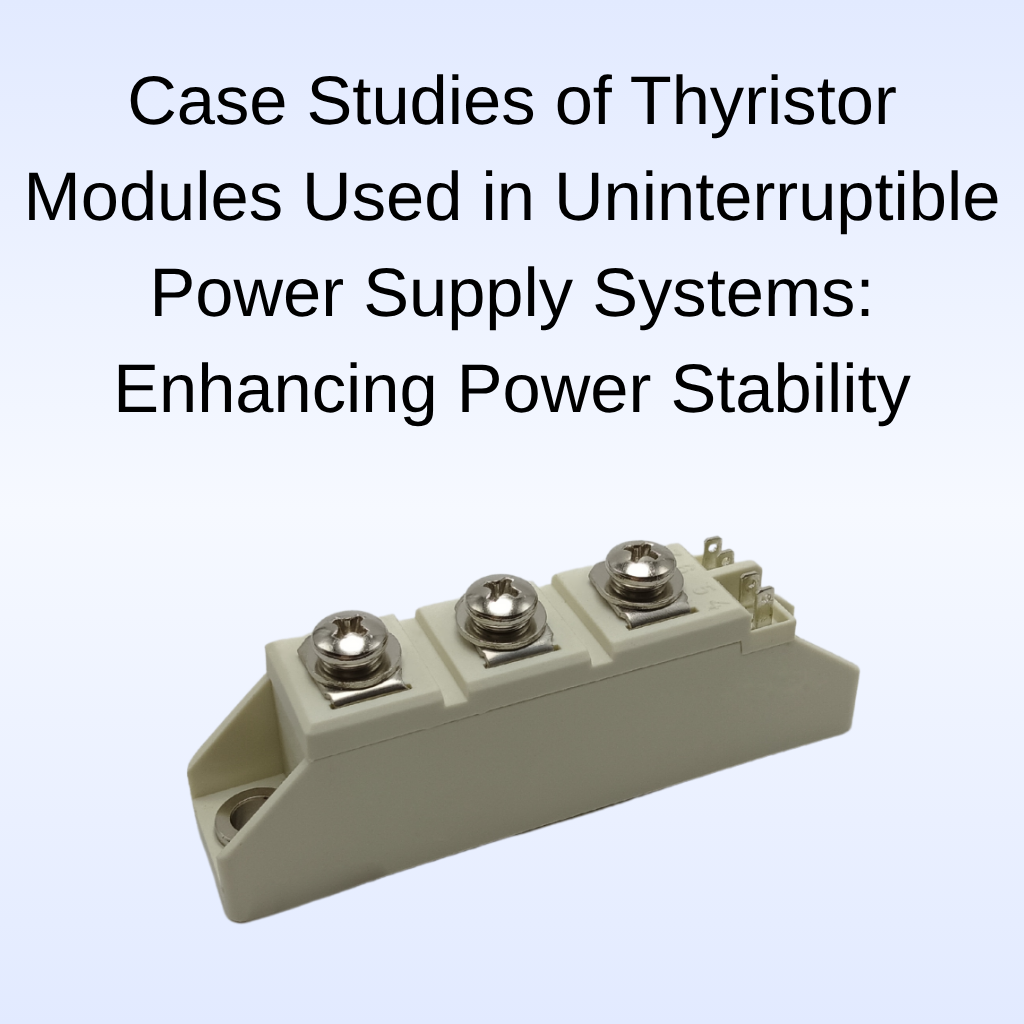Case Studies of Thyristor Modules Used in Uninterruptible Power Supply Systems: Enhancing Power Stability
Thyristor modules are essential components in Uninterruptible Power Supply (UPS) systems, particularly in applications where power continuity and reliability are critical. From industrial settings to healthcare facilities, these modules ensure that sensitive equipment is protected and remains operational even during power disruptions. This article explores several case studies where thyristor modules have been effectively employed to improve the performance and stability of UPS systems.
Case Study 1: High Surge Current Management in a Telecom Facility
A telecom facility required a UPS system capable of handling frequent power surges that could potentially damage sensitive communication equipment. The solution was to incorporate thyristor modules with enhanced high surge current capabilities. These modules ensured that the UPS system could absorb the power surges without affecting the performance of the equipment. Additionally, the use of dual thyristor modules improved the system’s reliability, ensuring continuous operation during power spikes. The combination of low on-state voltage and high surge current tolerance ensured that the system was both efficient and robust, protecting the telecom facility's operations from power disruptions.
Case Study 2: Temperature Control in Critical Data Centers
In a data center, maintaining a stable temperature and power supply is critical for the protection of sensitive servers and networking equipment. To ensure continuous and safe operation, the UPS system was enhanced with thyristor modules that incorporated temperature control features. These modules helped maintain the operating temperature of key components while ensuring efficient power conversion. The addition of industrial phase control ensured that the UPS system could provide stable voltage even during sudden changes in load. The dual thyristor module design added redundancy, making the system more reliable and preventing downtime caused by component failure.
Case Study 3: Smart Grid Integration for Energy Efficiency in a Research Facility
A research facility needed to improve its energy management and power supply reliability by integrating its UPS system with a smart grid. Thyristor modules designed for smart grid compatibility were added to the UPS system, allowing it to interact with the grid and optimize energy use. These modules offered excellent high surge current capabilities and low on-state voltage, which reduced energy loss during power conversion. The system was able to respond dynamically to power demand and integrate with the grid’s load balancing features. As a result, the research facility was able to reduce energy waste and improve the overall efficiency of its operations.
Case Study 4: Power Factor Correction in an Industrial Facility
An industrial facility was facing issues with low power factor, which was leading to inefficient energy consumption and higher operational costs. To resolve this, the facility’s UPS system was upgraded with thyristor modules that included HVDC power factor correction. This feature improved the system’s energy efficiency and reduced power losses. The integration of industrial phase control ensured that the power supply remained stable during varying load conditions, and the use of dual thyristor modules increased the system's ability to handle higher loads without any compromise on performance. The facility saw a significant reduction in power consumption and operating costs after implementing these upgrades.
Case Study 5: Soft-Start Battery Charger in a Medical Facility
A critical medical facility needed a UPS system that could provide stable power to life-saving medical equipment without causing power surges during startup. Thyristor modules with soft-start battery chargers were incorporated into the system. These modules allowed the UPS system to gradually increase the load on startup, preventing sudden power spikes that could harm sensitive equipment. The dual thyristor module design added redundancy, ensuring that the system remained operational even if one module failed. The overall system efficiency was enhanced with the use of low on-state voltage, which minimized energy waste and increased the facility’s operational savings.
Conclusion
The use of advanced thyristor modules in UPS systems has proven to be highly beneficial across various industries, from data centers to manufacturing plants and healthcare facilities. Features like high surge current handling, low on-state voltage, industrial phase control, and dual thyristor modules enhance the reliability, efficiency, and longevity of these systems. As demonstrated by these case studies, selecting the right thyristor modules for specific applications ensures that critical equipment remains operational, even during power disruptions.
READ MORE:
Installation and Maintenance Guide for Thyristor Modules in UPS Systems: Optimizing Performance
Installation and Maintenance Guide for Thyristor Modules in UPS Systems
Case Studies of Thyristor Modules in Uninterruptible Power Supply Systems: Applications in Industry
Case Studies of Thyristor Modules Used in Uninterruptible Power Supply Systems
Best Practices for Selecting Thyristor Modules in UPS Systems

